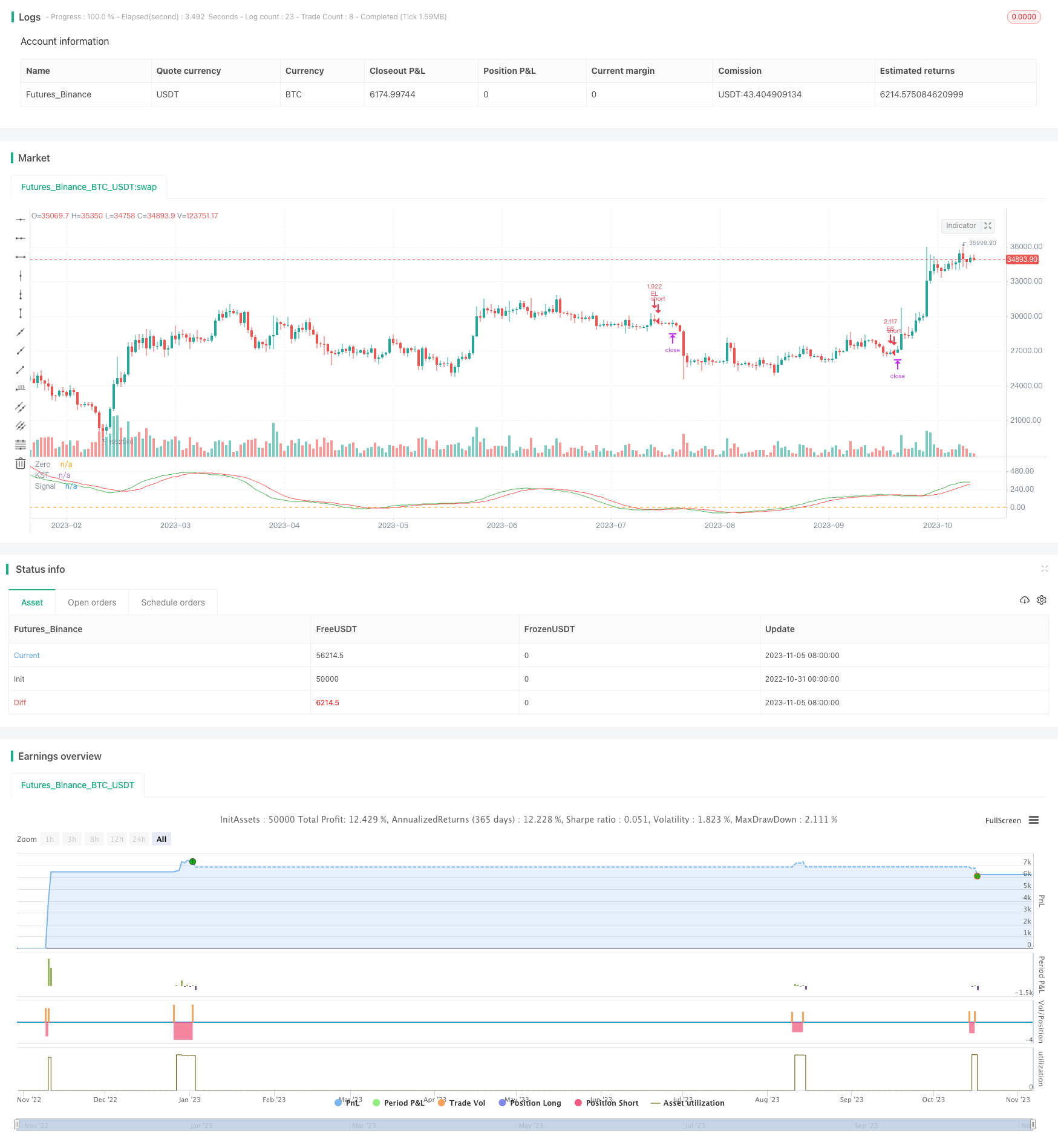
概述
本策略的核心思想是结合KST指标和EMA均线,实现对趋势的判断和跟随。当KST指标出现金叉并低于0时买入,当出现死叉并高于0时卖出。同时结合EMA均线作为支撑阻力,只有收盘价突破EMA均线时才发出交易信号。该策略简单实用,可以自动跟踪趋势,适合中长期持仓。
策略原理
计算KST指标:分别计算10日、15日、20日、30日的ROC指标,再分别对其加权求和,最后通过一个9日SMA平滑得到KST指标。
计算EMA均线:计算长度为50的EMA均线。
产生买入信号:当KST指标的快线上穿慢线(金叉)并低于0,同时收盘价高于EMA均线时,产生买入信号。
产生卖出信号:当KST指标的快线下穿慢线(死叉)并高于0,同时收盘价低于EMA均线时,产生卖出信号。
设置移动止损:跟踪止损设置为账户价值的1%,实现自动止损。
策略优势
KST指标可以识别趋势变化,EMA均线可以确认趋势方向,二者结合可以准确判断ENTRY时机。
采用快慢交叉结合0轴判断KST指标方向,避免无谓交易。
EMA均线作为支撑阻力,进一步过滤假信号,只在突破EMA时入场。
自动跟踪止损来控制风险,让盈利运行。
策略参数较少,容易实现和优化。
策略风险
KST指标对趋势变化判断有滞后,可能错过部分机会。可以缩短计算周期或优化加权方式。
EMA均线有滞后性,在趋势转折点可能失效。可以试验其他指标或多均线组合。
止损设置过于宽松会让亏损扩大;过于紧凑会被隔夜大幅波动止损。需要仔细测试找到平衡点。
策略信号频繁,交易成本可能较高。可以适当放宽入场条件,减少交易次数。
策略优化方向
优化KST指标的计算周期参数,找到对特定品种更敏感的参数组合。
测试不同的均线指标或组合,如MA、WMA等,看哪种与KST配合效果更好。
尝试根据波动率或ATR动态调整止损幅度。
增加过滤条件,如交易量突增等,避免被套。
考虑结合其他指标,如RSI、MACD等,使策略更全面。
测试不同品种参数效果,制定适应不同品种的优化方案。
总结
本策略整体思路清晰、可靠、容易实现,通过KST指标判断趋势转折,EMA均线进一步过滤,止损控制风险,可以自动跟踪中长线趋势。参数选取合理、优化空间大,用户可以根据需要调整参数,适用于不同品种,具有良好的普适性。本策略既适合新手学习,也可为专业交易者提供方向。通过继续优化测试,本策略有望成为稳定可靠的趋势跟随策略。
/*backtest
start: 2022-10-31 00:00:00
end: 2023-11-06 00:00:00
period: 1d
basePeriod: 1h
exchanges: [{"eid":"Futures_Binance","currency":"BTC_USDT"}]
*/
//@version=4
strategy(title="Know Sure Thing and EMA Strategy by JLX", shorttitle="KST EMA JLX", format=format.price, precision=4, initial_capital = 1000, default_qty_type=strategy.percent_of_equity, default_qty_value = 100)
roclen1 = input(10, minval=1, title = "ROC Length #1")
roclen2 = input(15, minval=1, title = "ROC Length #2")
roclen3 = input(20, minval=1, title = "ROC Length #3")
roclen4 = input(30, minval=1, title = "ROC Length #4")
smalen1 = input(10, minval=1, title = "SMA Length #1")
smalen2 = input(10, minval=1, title = "SMA Length #2")
smalen3 = input(10, minval=1, title = "SMA Length #3")
smalen4 = input(15, minval=1, title = "SMA Length #4")
siglen = input(9, minval=1, title = "Signal Line Length")
smaroc(roclen, smalen) => sma(roc(close, roclen), smalen)
kst = smaroc(roclen1, smalen1) + 2 * smaroc(roclen2, smalen2) + 3 * smaroc(roclen3, smalen3) + 4 * smaroc(roclen4, smalen4)
sig = sma(kst, siglen)
plot(kst, color=color.green, title="KST")
plot(sig, color=color.red, title="Signal")
hline(0, title="Zero")
len = input(50, minval=1, title="Length EMA")
src = input(close, title="Source EMA")
offset = input(title="Offset", type=input.integer, defval=0, minval=-500, maxval=500)
fastEMA = ema(src, len)
delta = kst - sig
buySignal = crossover(delta, 0) and kst < 0 and close > fastEMA
sellSignal = crossunder(delta, 0) and kst > 0 and close < fastEMA
longTrailPerc = input(title="Trail Long Loss (%)", type=input.float, minval=0.0, step=0.1, defval=1) * 0.01
shortTrailPerc = input(title="Trail Short Loss (%)",type=input.float, minval=0.0, step=0.1, defval=1) * 0.01
// STEP 2:
// Determine trail stop loss prices
longStopPrice = 0.0, shortStopPrice = 0.0
longStopPrice := if (strategy.position_size > 0)
stopValue = close * (1 - longTrailPerc)
max(stopValue, longStopPrice[1])
else
0
shortStopPrice := if (strategy.position_size < 0)
stopValue = close * (1 + shortTrailPerc)
min(stopValue, shortStopPrice[1])
else
999999
// Submit entry orders
if (buySignal)
strategy.entry(id="EL", long=true)
if (sellSignal)
strategy.entry(id="ES", long=false)
// STEP 3:
// Submit exit orders for trail stop loss price
if (strategy.position_size > 0)
strategy.exit(id="XL TRL STP", stop=longStopPrice)
if (strategy.position_size < 0)
strategy.exit(id="XS TRL STP", stop=shortStopPrice)
alertcondition(crossover(delta, 0) and kst < 0 and close > fastEMA,'Long alert', 'You should buy')
alertcondition(crossunder(delta, 0) and kst > 0 and close < fastEMA, 'Short alert', 'You should sell')